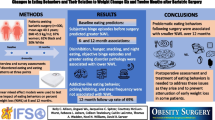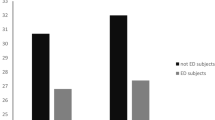Abstract
This systematic review evaluates the current evidence base for eating behavior changes after laparoscopic adjustable gastric banding (LAGB). A literature search from 1990 to February 2010 was conducted to identify original studies that assessed eating behavior in adults who have undergone LAGB. Sixteen articles (14 separate studies) met inclusion criteria. Although strength of the evidence base was limited by observational study designs and methodological weaknesses, results suggest that positive changes in eating behavior occur after surgery, including reduced over-eating in response to emotional and situational cues. There is some evidence to suggest that uncontrolled eating behaviors persist in some individuals, and that this may be problematic for weight loss after surgery. Few studies examined the relationship between changes in eating behavior and weight loss; thus, optimal behavioral strategies for promoting positive weight outcomes remain unclear. Further interventional research addressing the inherent limitations of the current-evidence base is required to guide development of evidence-based management guidelines for LAGB in future.

Similar content being viewed by others
References
World Health Organisation. Obesity and overweight. Accessed from http://www.who.int/mediacentre/factsheets/fs311/en/index.html. Accessed on June 25, 2008.
Kouris-Blazos A, Wahlqvist ML. Health economics of weight management: evidence and cost. Asia Pac J Clin Nutr. 2007;16 Suppl 1:329–38.
Gasteyger C, Suter M, Calmes JM, Gaillard RC, Giusti V. Changes in body composition, metabolic profile and nutritional status 24 months after gastric banding. Obes Surg. 2006;16:243–50.
O'Brien PE, Brown W. Obesity is a surgical disease: overview of obesity and bariatric surgery. ANZ J Surg. 2004;74:200–4.
Colquitt J, Clegg A, Loveman E, Royle P, Sidhu MK. Surgery for morbid obesity. Cochrane Database Syst Rev. 2005:CD003641.
Buchwald H, Estok R, Fahrbach K, Banel D, Jensen MD, Pories WJ, et al. Weight and type 2 diabetes after bariatric surgery: systematic review and meta-analysis. Am J Med. 2009;122:248–56.
Sjostrom L. Bariatric surgery and reduction in morbidity and mortality: experiences from the SOS study. Int J Obes. 2008;32:S93–7.
Tice JA, Karliner L, Walsh J, Petersen AJ, Feldman MD. Gastric banding or bypass? A systematic review comparing the two most popular bariatric procedures. Am J Med. 2008;121:885–93.
Farrell TM, Haggerty SP, Overby DW, Kohn GP, Richardson WS, Fanelli RD. Clinical application of laparoscopic bariatric surgery: an evidence-based review. Surg Endosc. 2009;23:930–49.
O'Brien PE, Brown WA, Dixon JB. Obesity, weight loss and bariatric surgery. Med J Aust. 2005;183:310–4.
Suter M, Calmes JM, Paroz A, Giusti V. A 10-year experience with laparoscopic gastric banding for morbid obesity: high long-term complication and failure rates. Obes Surg. 2006;16:829–35.
Langer FB, Bohdjalian A, Shakeri-Manesch S, Felberbauer FX, Ludvik B, Zacherl J, et al. Inadequate weight loss vs secondary weight regain: laparoscopic conversion from gastric banding to Roux-en-Y Gastric Bypass. Obes Surg. 2008;18:1381–6.
Schweitzer DH, van den Doel-Tanis N, Oei HI. Successful weight loss surgery improves eating control and energy metabolism: a review of the evidence. Obes Surg. 2007;17:533–9.
Tolonen P, Victorzon M, Makela J. 11-year experience with laparoscopic adjustable gastric banding for morbid obesity—what happened to the first 123 patients? Obes Surg. 2008;18:251–5.
De Panfilis C, Cero S, Torre M, Salvatore P, Dall'Aglio E, Adorni A, et al. Utility of the temperament and character inventory (TCI) in outcome prediction of laparoscopic adjustable gastric banding: preliminary report. Obes Surg. 2006;16:842–7.
Shah M, Simha V, Garg A. Review: long-term impact of bariatric surgery on body weight, comorbidities, and nutritional status. J Clin Endocrinol Metab. 2006;91:4223–31.
Bloomberg RD, Fleishman A, Nalle JE, Herron DM, Kini S. Nutritional deficiencies following bariatric surgery: what have we learned? Obes Surg. 2005;15:145–54.
Davies DJ, Baxter JM, Baxter JN. Nutritional deficiencies after bariatric surgery. Obes Surg. 2007;17:1150–8.
Malinowski SS. Nutritional and metabolic complications of bariatric surgery. Am J Med Sci. 2006;331:219–25.
Mechanick JI, Kushner RF, Sugerman HJ, Gonzalez-Campoy JM, Collazo-Clavell ML, Guven S, et al. Medical guidelines for clinical practice for the perioperative nutritional, metabolic, and nonsurgical support of the bariatric surgery patient. Endocr Pract. 2008;14 Suppl 1:1–83.
Aills L, Blankenship J, Buffington C, Furtado M, Parrott J. ASMBS allied health nutritional guidelines for the surgical weight loss patient. Surg Obes Relat Dis. 2008;4:S73–108.
Herpertz S, Kielmann R, Wolf AM, Langkafel M, Senf W, Hebebrand J. Does obesity surgery improve psychosocial functioning? A systematic review. Int J Obes Relat Metab Disord. 2003;27:1300–14.
Herpertz S, Kielmann R, Wolf AM, Hebebrand J, Senf W. Do psychosocial variables predict weight loss or mental health after obesity surgery? A systematic review. Obes Res. 2004;12:1554–69.
Effective Public Health Practice Project. Quality Assessment Tool for Quantitative Studies. Available from: http://www.ephpp.ca/tools.html. Accessed March 10, 2010.
Deeks JJ, Dinnes J, D'Amico R, Sowden AJ, Sakarovitch C, Song F, et al. Evaluating non-randomised intervention studies. Health Technol Assess. 2003;7(iii-x):1–173.
Thomas BH, Ciliska D, Dobbins M, Micucci S. A process for systematically reviewing the literature: providing the research evidence for public health nursing interventions. Worldviews Evid Based Nurs. 2004;1:176–84.
National Health and Medical Research Council. How to use the evidence: assessment and application of scientific evidence. Commonwealth of Australia: Canberra; 2000. p. 1–84.
Chevallier JM, Paita M, Rodde-Dunet MH, Marty M, Nogues F, Slim K. Predictive factors of outcome after gastric banding: a nationwide survey on the role of center activity and patients’ behavior. Ann Surg. 2007;246:1034–9.
Himpens J, Dapri G, Cadiere GB. A prospective randomized study between laparoscopic gastric banding and laparoscopic isolated sleeve gastrectomy: results after 1 and 3 years. Obes Surg. 2006;16:1450–6.
Nickel C, Widermann C, Harms D, Leiberich PL, Tritt K, Kettler C. Patients with extreme obesity: change in mental symptoms three years after gastric banding. Int J Psychiatry Med. 2005;35:109–22.
Nickel MK, Loew TH, Bachler E. Change in mental symptoms in extreme obesity patients after gastric banding, part II: six-year follow up. Int J Psychiatry Med. 2007;37:69–79.
Poole NA, Al Atar A, Kuhanendran D, Bidlake L, Fiennes A, McCluskey S. Compliance with surgical after-care following bariatric surgery for morbid obesity: a retrospective study. Obes Surg. 2005;15:261–5.
Bueter M, Thalheimer A, Lager C, Schowalter M, Illert B, Fein M. Who benefits from gastric banding? Obes Surg. 2007;17:1608–13.
Colles SL, Dixon JB, O'Brien PE. Hunger control and regular physical activity facilitate weight loss after laparoscopic adjustable gastric banding. Obes Surg. 2008;18:833–40.
Colles SL, Dixon JB, O'Brien PE. Grazing and loss of control related to eating: two high-risk factors following bariatric surgery. Obesity. 2008;16:615–22.
De Panfilis C, Cero S, Torre M, Salvatore P, Dall'Aglio E, Adorni A. Changes in body image disturbance in morbidly obese patients 1 year after laparoscopic adjustable gastric banding.[Erratum appears in Obes Surg. 2007 Jul;17(7):996]. Obes Surg. 2007;17:792–9.
Horchner R, Tuinebreijer W, Kelder H. Eating patterns in morbidly obese patients before and after a gastric restrictive operation. Obes Surg. 2002;12:108–12.
Hudson SM, Dixon JB, O'Brien PE. Sweet eating is not a predictor of outcome after Lap-Band(registered trademark) placement. Can we finally bury the myth? Obes Surg. 2002;12:789–94.
Lang T, Hauser R, Buddeberg C, Klaghofer R. Impact of gastric banding on eating behavior and weight. Obes Surg. 2002;12:100–7.
Schindler K, Prager G, Ballaban T, Kretschmer S, Riener R, Buranyi B. Impact of laparoscopic adjustable gastric banding on plasma ghrelin, eating behaviour and body weight. Eur J Clin Investig. 2004;34:549–54.
Scholtz S, Bidlake L, Morgan J, Fiennes A, El-Etar A, Lacey JH. Long-term outcomes following laparoscopic adjustable gastric banding: postoperative psychological sequelae predict outcome at 5-year follow-up. Obes Surg. 2007;17:1220–5.
Larsen JK, Van Ramshorst B, Geenen R, Brand N, Stroebe W, Van Doornen LJP. Binge eating and its relationship to outcome after laparoscopic adjustable gastric banding. Obes Surg. 2004;14:1111–7.
Zijlstra H, Larsen JK, Van Ramshorst B, Geenen R. The association between weight loss and self-regulation cognitions before and after laparoscopic adjustable gastric banding for obesity: a longitudinal study. Surgery. 2006;139:334–9.
Stunkard AJ, Messick S. The three-factor eating questionnaire to measure dietary restraint, disinhibition and hunger. J Psychosom Res. 1985;29:71–83.
Busetto L, Pisent C, Segato G, De Marchi F, Favretti F, Lise M. The influence of a new timing strategy of band adjustment on the vomiting frequency and the food consumption of obese women operated with laparoscopic adjustable silicone gastric banding (LAP-BAND). Obes Surg. 1997;7:505–12.
Busetto L, Valente P, Pisent C, Segato G, de Marchi F, Favretti F. Eating pattern in the first year following adjustable silicone gastric banding (ASGB) for morbid obesity. Int J Obes Relat Metab Disord. 1996;20:539–46.
Coupaye M, Puchaux K, Bogard C, Msika S, Jouet P, Clerici C. Nutritional consequences of adjustable gastric banding and gastric bypass: a 1-year prospective study. Obes Surg. 2009;19:56–65.
Ernst B, Thurnheer M, Wilms B, Schultes B. Differential changes in dietary habits after gastric bypass versus gastric banding operations. Obes Surg. 2009;19:274–80.
Guida B, Belfiore A, Angrisani L, Micanti F, Mauriello C, Trio R. Laparoscopic gastric banding and body composition in morbid obesity. Nutr Metab Cardiovasc Dis. 2005;15:198–203.
Savastano S, Belfiore A, Guida B, Angrisani L, Orio Jr F, Cascella T. Role of dehydroepiandrosterone sulfate levels on body composition after laparoscopic adjustable gastric banding in pre-menopausal morbidly obese women. J Endocrinol Investig. 2005;28:509–15.
Sjostrom L, Lindroos AK, Peltonen M, Torgerson J, Bouchard C, Carlsson B. Lifestyle, diabetes, and cardiovascular risk factors 10 years after bariatric surgery. N Engl J Med. 2004;351:2683–93.
Wahlroos S, Phillips ML, Lewis MC, Kow L, Toouli J, Slavotinek JP. Rapid significant weight loss and regional lipid deposition: implications for insulin sensitivity. Obes Res Clin Prac. 2007;1:7–16.
Colquitt JL, Picot J, Loveman E, Clegg AJ. Surgery for obesity. Cochrane Database Syst Rev. 2009:CD003641.
Foster GD, Platte P, Vogt RA. The Eating Inventory in obese women: clinical correlates and relationship to weight loss. Int J Obes Relat Metab Disord. 1998;22:778–85.
Sugerman HJ, Birkenhauer R. A randomized prospective trial of gastric bypass versus vertical banded gastroplasty for morbid obesity and their effects on sweets versus non-sweets eaters. Ann Surg. 1987;205:613–24.
Kriwanek S, Blauensteiner W, Lebisch E, Beckerhinn P, Roka R. Dietary changes after vertical banded gastroplasty. Obes Surg. 2000;10:37–40.
Conflict of interest
The authors declare that they have no conflict of interest.
Author information
Authors and Affiliations
Corresponding author
Rights and permissions
About this article
Cite this article
Dodsworth, A., Warren-Forward, H. & Baines, S. Changes in Eating Behavior After Laparoscopic Adjustable Gastric Banding: A Systematic Review of the Literature. OBES SURG 20, 1579–1593 (2010). https://doi.org/10.1007/s11695-010-0270-4
Published:
Issue Date:
DOI: https://doi.org/10.1007/s11695-010-0270-4




